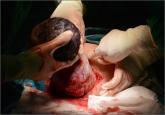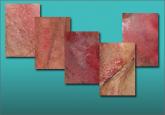Clinical Review

2014 Update on abnormal uterine bleeding
Randomized data shed light on AUB associated with fibroids, adenomyosis, and the use of progestins

Letters from readers
“UPDATE ON ABNORMAL UTERINE BLEEDING”
HOWARD T. SHARP, MD (MARCH 2015)
Still having reservations about ablation
We discussed Dr. Sharp’s update on abnormal uterine bleeding (AUB) at a recent clinical meeting in my office. I have long told my nurse practition-ers that I am not in favor of ablation for AUB associated with ovulatory dysfunction (AUB-O). I learned from recent recertification reading that the risks for failure of ablation are dysmenorrhea, tubal ligation, and obesity, not anovulation. Therefore I may be more lenient with the use of ablation in this situation.
I still have the same reservations about performing ablation in women with ongoing irregular bleeding: If patients continue to have irregular bleeding, which they often do, it can be difficult to evaluate the endometrial cavity due to scarring, even at the time of dilation and curettage. Therefore, if they have other risk factors for hyperplasia or endometrial cancer or have postmenopausal bleeding, I won’t offer them ablation.
Nancy Shumeyko, MD
Binghamton, New York
Dr. Sharp responds
I appreciate Dr. Shumeyko’s comments and concerns about endometrial sampling in patients with abnormal bleeding (specifically AUB-O)who may have endometrial scarring after endometrial ablation. This is one of the unsettling challenges of post-ablation bleeding that we must sometimes address. Unfortunately, this can occur even in patients who seem to be “ideal” candidates for endometrial ablation (AUB-E). With amenorrhea rates generally less than 50% with most ablative methods, this unintended consequence makes the levonorgestrel IUD look all the more appealing. Hence, I agree with Dr. Shumeyko, and would add that just because we can do something, doesn’t mean we should.
The important question is how to repair the incision
I read with interest Dr. Barbieri’s March editorial about hysterotomy during cesarean delivery. In my opinion, the important question is not how to open but how to repair.
I cannot dictate or even encourage other surgeons to do as I do because our surgical skills differ. I create a bladder flap on primary cesarean sections out of habit, but I have performed a few without creating it, and without harming the patient.
Personally, I open the lower uterine segment sharply unless copious bleeding hampers my view. Most of the time, I can gain entrance to the uterine cavity without performing a concurrent amniotomy, which allows me to sharply perform the hysterotomy without concern for injuring the fetus. If bleeding hampers my view, I do all the dissection bluntly.
Have I noticed a big difference one way or the other? Not at all.
It is my impression that a double-layered closure is beneficial to the patient. I close the hysterotomy in this fashion even if the patient would not be a candidate for a trial of labor after cesarean in future pregnancies.
Maybe I am just lucky, but I only remember having injured 1 baby (a breech presentation fetus with severe oligohydramnios) since I finished my residency in 1986.
Tomas Hernandez, MD
Pasco, Washington
Dr. Barbieri responds
I respect Dr. Hernandez’s 30 years of clinical experience and appreciate his recommendations on opening and closing of the hysterotomy at cesarean delivery. My observation is that most US obstetricians close the hysterotomy in 2 layers. Like Dr. Hernandez, I favor a double-layer closure even if the patient is not a candidate for a trial of labor in a future pregnancy.
ANSWERING YOUR CODING QUESTIONS
A reader recently requested assistance for a specific coding challenge. We’ve asked our reimbursement specialist, Melanie Witt, RN, CPC, COBGC, MA, to provide her insight.
How should we code when using CUSA on vulvar dysplasia?
I provide coding assistance for several ObGyn practices and have always found your Web site to be informative. My question concerns Current Procedural Terminology (CPT) coding for removal of vulvar dysplasia using the cavitron ultrasonic surgical aspirator. The device is used to remove diseased epithelium. Generally, acetic acid is applied to highlight the diseased area and the lesions are removed with the device. The aspirator also collects the removed tissue so that it can be sent to pathology. Silver sulfadiazine cream is applied to the areas treated, as in laser surgery. The treatment may take 10 to 15 minutes. Which code, 56620 or 56515, should be used to reflect the actual work involved?
Marie D. Pelino, CPC
Annapolis, Maryland
Ms. Witt responds
The clinical vignette that was used by the CPT Editorial Panel in valuing code 56620 (Vulvectomy simple; partial) reads1:

Randomized data shed light on AUB associated with fibroids, adenomyosis, and the use of progestins

Is there evidence of a best approach to managing the hysterotomy incision?

Although Medicare reimbursement looks bleak for the coming year, awareness of some coding changes could help your bottom line

When a patient reports chronic symptoms, it’s important to look beyond yeast infection and other common causes to accurately identify her...

Is ondansetron associated with congenital anomalies when used in early pregnancy?
